|
Finetta IV D
home Vintage Cameras Index | ||
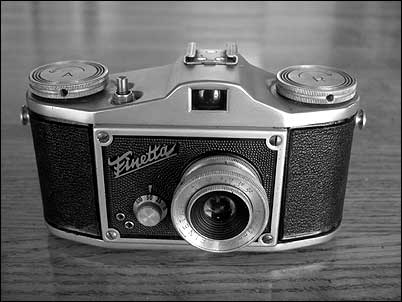
| The Finetta is a simple, but full featured 35mm camera. While the name may sound vaguely Italian, the camera was made in Germany in about 1950 at the Finetta Werk in Goslar. Features of the camera include a bakelite body with fabric or leather covering, an f:4/43mm Finetar lens with stops to f22, shutter speeds from 1/25 to 1/100 plus "B", double-exposure prevention, combined shutter cocking and film advance, flash synch, and frame counter. The leaf shutter under the front plate has a construction similar to many old box cameras and early folders with sliding levers and a lobed cam.
The Finetta is constructed quite solidly for a camera that probably sold originally in the U.S. for about $30. The top and bottom plates are solid metal. The bakelite front plate has its edges protected from chipping by a metal frame. Internal shutter and advance components are brass and steel. Later models had more advanced features including spring motor drive, focal plane shutter and interchangable bayonet-mount lenses. | |
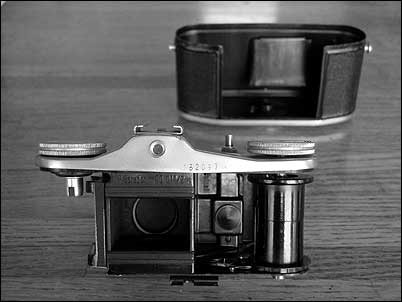 |
Turning the large knob on the camera's bottom to the "A" allows removal of the camera back for film loading. The standard 35mm casette is held in place after insertion by a swinging lever. The slot in the take-up spool is a little short for modern film leaders, so a small amount has to be trimmed off with sissors. One feature the camera lacks is a means of resetting the film counter, so before inserting the film, one must advance the counter by turning the advance knob to around the #35 mark in order to allow winding on enough leader and getting to the #1 position. Once the film is loaded and the back locked in place by setting the knob to the "Z", the operation of the camera is straight forward. Advancing the film pops up the shutter release. Focusing is accomplished by turning the lens to the estimated camera to subject distance, with a minimum focal distance of 2.5 feet. The aperture is selected with the knurled ring at the front of the lens. To rewind the film after the roll has been exposed, it is first necessary to free the advance mechanism so that it will turn freely. The Advance knob is lifted slightly and turned just a little so that it remains in an elevated postion. With the advance spool thus freed, it is then possible to use the Rewind knob to roll the film back into the cassette. | |
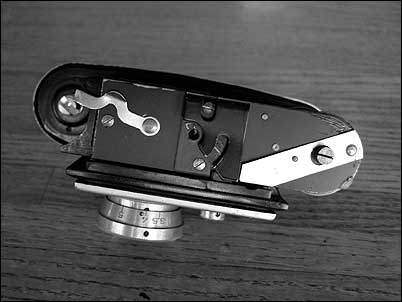 |
Nothing worked quite right on the Finetta when I first got it. The shutter was intermittent, the lens would not properly focus, and the film advance only worked half the time. The focus correction was quite simple. Taking off the focus ring by loosening the three small set-screws allowed me to screw in the lens to the stop, which is the correct infinity position. One does need to experiment a bit to get the right starting point of the threads in order for the aperture settings to properly line up with the index mark.
I put a small amount of light oil on the shutter components, which seemed to make it work a little more smoothly. However, it still seems that it is best to set the shutter before it is cocked by the film advance in order for it to function reliably. The most difficult thing was getting the film advance/shutter cocking mechanism to work properly. The internal bottom plate comes off by removing three screws, and one then has access to the advance drum and the little brass mechanism which controls the advance and double exposure prevention components. It turned out after many tries that I was able to get the advance working properly by sliding the plate sideways into position which seemed to properly engage the parts in a manner that was not entirely clear to me. | |
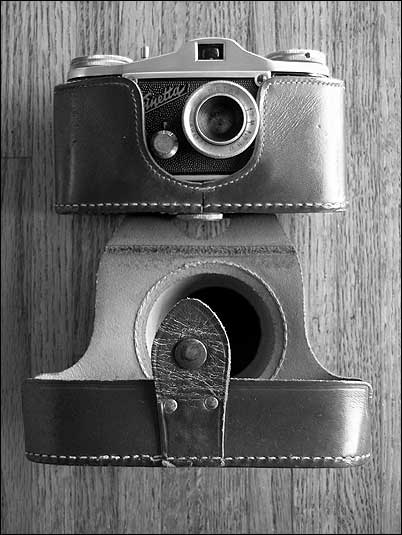 |
A peculiarity of the Finetta design is that frame spacing is entirely a function of the diameter of the take-up spool. Turning the advance rotates the spool 180 degrees each time. That means that the frame spacing gradually increases with each winding as the thickness of the rolled-on film increases on the spool. That arrangement would probably not have been a problem in the 1950's, but as processing and printing became more automated, the irregular frame spaces can produce some problems. In my Dimage IV scanner, for instance, the film strip has to be readjusted for scanning each frame, which is quite inconvenient.
Aside from that one issue, the camera is easy to operate, and it produces quite satisfying results. Like most German designs, the Finetta closes up securely with no need for troublesome foam rubber sealing strips. My Finetta still has its original sturdy leather case which has kept it in very fine condition over the last half-century. The case is stamped "Top Grain Cowhide. Made in U.S.A.", and on the top a ballpoint pen inscription proclaims the camera to have been originally the proud possession of "W.R. Edwards". I've called the camera a IV D Model based on this link, but haven't found other references to this particular model designation. Other models listed in my 1990 edition of McKeown's include:
| |
|
Some sample snapshots from the Finetta shot in La Mesilla, New Mexico. The last detail photo of the plaque under the Virgin shows the very nice sharpness of the Finetar lens. 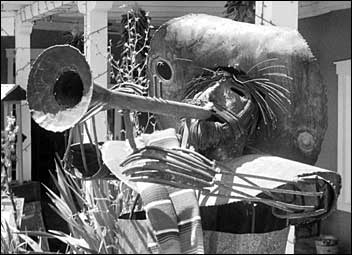
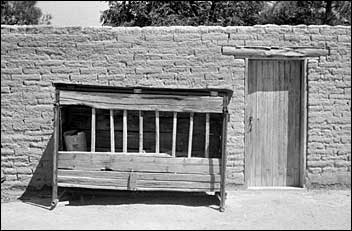 
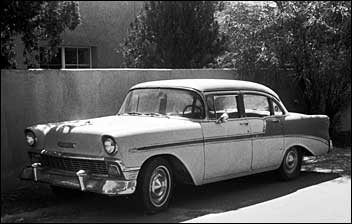 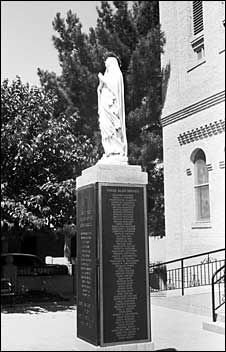
 | ||
A note from a Finetta user: | ||
|
home Vintage Cameras Index | ||
 © mike connealy
© mike connealy